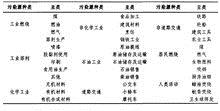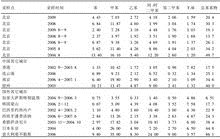The general term for benzene and derivatives, the benzene series in a broad sense includes all aromatic compounds, and the narrowly defined benzene-containing compounds including BTEX which have a certain distribution in the human production and living environment and cause harm to the human body. Due to production and domestic pollution, benzene compounds can be widely detected in human habitats and living environments. It also has a strong hazard to the blood, nerves and reproductive system of the human body. Developed countries generally regard the concentration of benzene in the atmosphere as one of the routine monitoring of the atmospheric environment, and stipulate strict indoor and outdoor air quality standards. Proportion of various sources of benzene series in the US statistical environment Historical evolution The study of benzene series dates back to the 19th century. As early as 1825, British scientist Faraday used distillation to separate higher purity benzene from pyrolysis products such as fish oil, which was called "heavy carbon heavy carbon compound" and determined its basic physics. Nature and chemical composition. Since then, toluene, xylene and other substances have been discovered and named as benzene series. Industrial production of benzene began in 1865 and was originally recovered from coal tar. With the expansion of its use, production has continued to rise, and by 1930 it has become one of the world's top ten tonnage products. With the wide production and application of benzene series, its air pollution characteristics and toxicology research have gradually attracted people's attention. In 1928, Delore et al. reported the first benzene contact with acute lymphocytic leukemia. The monitoring and research of benzene-based pollution in the air around the 1970s has gradually become a hot spot. In 1968, William et al. sampled and analyzed the concentration of benzene in the air of the city of Los Angeles. The United States Environment Agency (EPA) monitored benzene concentrations in 12 cities in the United States for five consecutive years between 1979 and 1984. In the 1980s, with the increasing problem of micro-environment air pollution and people's attention to micro-environment air quality, the research focus of benzene-based pollution began to shift to the micro-environment air field. The US EPA reported that 35 volatile organic compounds were identified in the microenvironment air, and the most prominent pollutants were aromatic hydrocarbons and aliphatic hydrocarbons represented by toluene. Since then, many foreign scholars have studied the pollution of benzene series in various types of micro-environment air, including concentration levels, pollution characteristics, typical sources and human exposure. The earliest research began on the pollution of benzene in the micro-environment of households, and then began to pay attention to the air quality and health risks of other types of micro-environments such as offices, shopping malls, restaurants and so on. The research on benzene series in the micro-environment air started late in China. From the 1990s to the beginning of the 21st century, the corresponding concentration status investigation and source preliminary research were carried out. However, China's research on the pollution of benzene in the micro-environment air is still very systematic, and mainly focuses on the study of occupational exposure and the analysis methods and simple measurement of pollutant concentration. source Benzene series have a wide range of sources, such as automobile exhaust, organic solvents in building decoration materials, such as paint additives, and common gluing in daily life. Main source of benzene series Agents, wood-based panel furniture, etc. are all sources of pollution of benzene compounds. The composition and characteristics of benzene series from different sources are also different, and the emissions of benzene series from different sources are also different. The business card picture is the ratio of various sources of benzene series in the environment of the United States. It can be seen that among the fixed sources of benzene series, the benzene series emitted by vehicles account for the largest proportion, and the benzene series produced by using organic solvents Material emissions also account for a considerable proportion. Typical sources of benzene series in the microenvironment can be divided into indoor and outdoor sources according to their source locations. Contaminants enter the room in the form of air convection or infiltration, and their contribution rate to benzene in indoor air can be measured by the ratio of indoor to outdoor concentration (I/O). Beijing BETX distribution To evaluate, if the I/O value is less than 1 or close to 1, it indicates that the outdoor source is the main source of indoor pollution. The larger the I/O value, the greater the influence of outdoor air on the pollutant concentration. The I/O values ​​of benzene series in different types of indoor air in Beijing are greater than 1 except for the waiting area outside the station, indicating that the main source of benzene in indoor air in these places is indoor source. Typical sources of benzene series in microenvironment can be divided into industrial production, automobile exhaust, decoration and decoration materials (such as paints, plates, decorative materials, etc.) and office equipment (such as copiers, printers, fax machines, computers) according to the nature and type of pollution sources. Etc.), human activities (such as smoking, cooking, burning incense, etc.). According to its production mechanism, it can be divided into volatilization sources (such as paints, adhesives, etc.) and combustion sources (such as mosquito coils). Comparison of benzene concentrations in the atmosphere of Beijing with other cities Incense, tobacco smoke, etc.) and composite sources (such as cooking fumes, car exhaust, printer exhaust, etc.). Differences in the mechanism of production will result in differences in the concentration and contamination characteristics of the benzene series. * There are numerous small poles on the surface of the Bath Mat, it can absorb water immediately. Printing Bath Mat,Custom Diatomaceous Mat,Bathroom Floor Diatom Mat,Diatomaceous Earth Bath Mat zhangjiagang wellyoung material co.,ltd , https://www.wellyoung-board.com


* The main material is natural mineral, diatomite, give full play to the advantages, features and function of natural materials. Safe! Relieved!
* It not only can absorb moisture, but also have the effect of removing smell, VQC (such as formaldehyde and other volatile organic compounds) absorption, humidity control.
* Compare with general bath mat, diatomite mat has very strong resistance to mold propagation, and won't leave any living space to mould and mites.
* No need to wash, always keep clean and dry.
* Beautiful shape also provide you happy feeling...